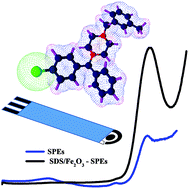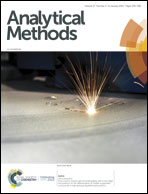Disposable screen-printed electrodes modified with uniform iron oxide nanocubes for the simple electrochemical determination of meclizine, an antihistamine drug†
Abstract
Meclizine (MEC) is an antihistamine drug with long action and moderate sedative effects. It is commonly used in management of nausea, motion sickness and vomiting. Herein, a disposable screen-printed carbon electrode modified with uniform iron oxide nanocubes (Fe2O3 NCs-SPEs) was explored for simple electrochemical determination of MEC. The influence of the supporting electrolyte on the voltammetric signal of MEC was studied by using cyclic voltammetry. A sharp irreversible oxidation wave was observed at +1.5 V (vs. pseudo Ag/AgCl). The Fe2O3 NCs-SPEs showed an enhanced voltammetric signal of MEC in 0.05 M H2SO4, which significantly increased in the presence of sodium dodecyl sulfate (SDS). The optimum experimental parameters for differential pulse voltammetry (DPV) were studied. It was found that MEC can be easily determined in an aqueous 0.05 M H2SO4 solution over a wide linear range of 6.66–196.08 μM with a detection limit of 1.69 μM based on a 3.3 S/N ratio. The analysis of MEC in pharmaceutical formulations and human urine samples with satisfactory recoveries revealed the potential applicability of Fe2O3 NCs-SPEs for on-site analysis.

- This article is part of the themed collection: Electrochemistry for health applications


 Please wait while we load your content...
Please wait while we load your content...